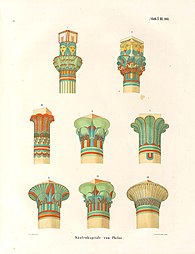
A | B | C | D | E | F | G | H | CH | I | J | K | L | M | N | O | P | Q | R | S | T | U | V | W | X | Y | Z | 0 | 1 | 2 | 3 | 4 | 5 | 6 | 7 | 8 | 9
Ancient Egypt | |||||||||
|---|---|---|---|---|---|---|---|---|---|
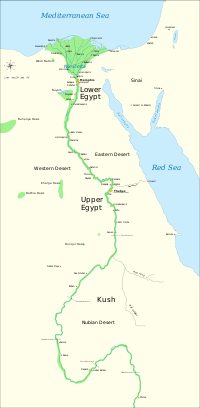 Map of ancient Egypt, showing major cities and sites of the Dynastic period (c. 3150 BC to 30 BC) | |||||||||
| |||||||||
| Periods and dynasties of ancient Egypt |
|---|
|
All years are BC |
Ancient Egypt was a civilization of ancient Northeast Africa. It was concentrated along the lower reaches of the Nile River, situated in the place that is now the country Egypt. Ancient Egyptian civilization followed prehistoric Egypt and coalesced around 3100 BC (according to conventional Egyptian chronology)[1] with the political unification of Upper and Lower Egypt under Menes (often identified with Narmer).[2] The history of ancient Egypt unfolded as a series of stable kingdoms interspersed by periods of relative instability known as “Intermediate Periods.” The various kingdoms fall into one of three categories: the Old Kingdom of the Early Bronze Age, the Middle Kingdom of the Middle Bronze Age, or the New Kingdom of the Late Bronze Age.
Ancient Egypt reached the pinnacle of its power during the New Kingdom, ruling much of Nubia and a sizable portion of the Levant. After this period, it entered an era of slow decline. During the course of its history, Ancient Egypt was invaded or conquered by a number of foreign powers, including the Hyksos, the Nubians, the Assyrians, the Achaemenid Persians, and the Macedonians under Alexander the Great. The Greek Ptolemaic Kingdom, formed in the aftermath of Alexander's death, ruled until 30 BC, when, under Cleopatra, it fell to the Roman Empire and became a Roman province.[3] Egypt remained under Roman control until the 640s AD, when it was conquered by the Rashidun Caliphate.
The success of ancient Egyptian civilization came partly from its ability to adapt to the conditions of the Nile River valley for agriculture. The predictable flooding and controlled irrigation of the fertile valley produced surplus crops, which supported a more dense population, and social development and culture. With resources to spare, the administration sponsored mineral exploitation of the valley and surrounding desert regions, the early development of an independent writing system, the organization of collective construction and agricultural projects, trade with surrounding regions, and a military intended to assert Egyptian dominance. Motivating and organizing these activities was a bureaucracy of elite scribes, religious leaders, and administrators under the control of a pharaoh, who ensured the cooperation and unity of the Egyptian people in the context of an elaborate system of religious beliefs.[4]
The many achievements of the ancient Egyptians include the quarrying, surveying, and construction techniques that supported the building of monumental pyramids, temples, and obelisks; a system of mathematics, a practical and effective system of medicine, irrigation systems, and agricultural production techniques, the first known planked boats,[5] Egyptian faience and glass technology, new forms of literature, and the earliest known peace treaty, made with the Hittites.[6] Ancient Egypt has left a lasting legacy. Its art and architecture were widely copied, and its antiquities were carried off to far corners of the world. Its monumental ruins have inspired the imaginations of travelers and writers for millennia. A newfound respect for antiquities and excavations in the early modern period by Europeans and Egyptians has led to the scientific investigation of Egyptian civilization and a greater appreciation of its cultural legacy.[7]

History
The Nile has been the lifeline of its region for much of human history.[8] The fertile floodplain of the Nile gave humans the opportunity to develop a settled agricultural economy and a more sophisticated, centralized society that became a cornerstone in the history of human civilization.[9] Nomadic modern human hunter-gatherers began living in the Nile valley through the end of the Middle Pleistocene some 120,000 years ago. By the late Paleolithic period, the arid climate of Northern Africa had become increasingly hot and dry, forcing the populations of the area to concentrate along the river region.
Predynastic period

In Predynastic and Early Dynastic times, the Egyptian climate was much less arid than it is today. Large regions of Egypt were covered in treed savanna and traversed by herds of grazing ungulates. Foliage and fauna were far more prolific in all environs, and the Nile region supported large populations of waterfowl. Hunting would have been common for Egyptians, and this is also the period when many animals were first domesticated.[10]
By about 5500 BC, small tribes living in the Nile valley had developed into a series of cultures demonstrating firm control of agriculture and animal husbandry, and identifiable by their pottery and personal items, such as combs, bracelets, and beads. The largest of these early cultures in upper (Southern) Egypt was the Badarian culture, which probably originated in the Western Desert; it was known for its high-quality ceramics, stone tools, and its use of copper.[11]
The Badari was followed by the Naqada culture: the Naqada I (Amratian), the Naqada II (Gerzeh), and Naqada III (Semainean).[12] These brought a number of technological improvements. As early as the Naqada I Period, predynastic Egyptians imported obsidian from Ethiopia, used to shape blades and other objects from flakes.[13][14] Mutual trade with the Levant was established during Naqada II (c. 3600–3350 BC); this period was also the beginning of trade with Mesopotamia, which continued into the early dynastic period and beyond.[15] Over a period of about 1,000 years, the Naqada culture developed from a few small farming communities into a powerful civilization whose leaders were in complete control of the people and resources of the Nile valley.[16] Establishing a power center at Nekhen (in Greek, Hierakonpolis), and later at Abydos, Naqada III leaders expanded their control of Egypt northwards along the Nile.[17] They also traded with Nubia to the south, the oases of the western desert to the west, and the cultures of the eastern Mediterranean and Near East to the east.[18][when?]
The Naqada culture manufactured a diverse selection of material goods, reflective of the increasing power and wealth of the elite, as well as societal personal-use items, which included combs, small statuary, painted pottery, high quality decorative stone vases, cosmetic palettes, and jewelry made of gold, lapis, and ivory. They also developed a ceramic glaze known as faience, which was used well into the Roman Period to decorate cups, amulets, and figurines.[19][20] During the last predynastic phase, the Naqada culture began using written symbols that eventually were developed into a full system of hieroglyphs for writing the ancient Egyptian language.[21]

Early Dynastic Period (c. 3150–2686 BC)
The Early Dynastic Period was approximately contemporary to the early Sumerian-Akkadian civilization of Mesopotamia and of ancient Elam. The third-century BC Egyptian priest Manetho grouped the long line of kings from Menes to his own time into 30 dynasties, a system still used today. He began his official history with the king named "Meni" (or Menes in Greek), who was believed to have united the two kingdoms of Upper and Lower Egypt.[22]
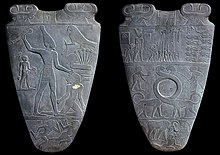
The transition to a unified state happened more gradually than ancient Egyptian writers represented, and there is no contemporary record of Menes. Some scholars now believe, however, that the mythical Menes may have been the king Narmer, who is depicted wearing royal regalia on the ceremonial Narmer Palette, in a symbolic act of unification.[24] In the Early Dynastic Period, which began about 3000 BC, the first of the Dynastic kings solidified control over lower Egypt by establishing a capital at Memphis, from which he could control the labor force and agriculture of the fertile delta region, as well as the lucrative and critical trade routes to the Levant. The increasing power and wealth of the kings during the early dynastic period was reflected in their elaborate mastaba tombs and mortuary cult structures at Abydos, which were used to celebrate the deified king after his death.[25] The strong institution of kingship developed by the kings served to legitimize state control over the land, labor, and resources that were essential to the survival and growth of ancient Egyptian civilization.[26]
Old Kingdom (2686–2181 BC)
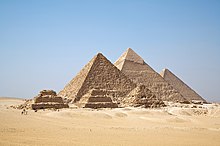
Major advances in architecture, art, and technology were made during the Old Kingdom, fueled by the increased agricultural productivity and resulting population, made possible by a well-developed central administration.[27] Some of ancient Egypt's crowning achievements, the Giza pyramids and Great Sphinx, were constructed during the Old Kingdom. Under the direction of the vizier, state officials collected taxes, coordinated irrigation projects to improve crop yield, drafted peasants to work on construction projects, and established a justice system to maintain peace and order.[28]

With the rising importance of central administration in Egypt, a new class of educated scribes and officials arose who were granted estates by the king in payment for their services. Kings also made land grants to their mortuary cults and local temples, to ensure that these institutions had the resources to worship the king after his death. Scholars believe that five centuries of these practices slowly eroded the economic vitality of Egypt, and that the economy could no longer afford to support a large centralized administration.[29] As the power of the kings diminished, regional governors called nomarchs began to challenge the supremacy of the office of king. This, coupled with severe droughts between 2200 and 2150 BC,[30] is believed to have caused the country to enter the 140-year period of famine and strife known as the First Intermediate Period.[31]
First Intermediate Period (2181–2055 BC)
After Egypt's central government collapsed at the end of the Old Kingdom, the administration could no longer support or stabilize the country's economy. Regional governors could not rely on the king for help in times of crisis, and the ensuing food shortages and political disputes escalated into famines and small-scale civil wars. Yet despite difficult problems, local leaders, owing no tribute to the king, used their new-found independence to establish a thriving culture in the provinces. Once in control of their own resources, the provinces became economically richer—which was demonstrated by larger and better burials among all social classes.[32] In bursts of creativity, provincial artisans adopted and adapted cultural motifs formerly restricted to the royalty of the Old Kingdom, and scribes developed literary styles that expressed the optimism and originality of the period.[33]
Free from their loyalties to the king, local rulers began competing with each other for territorial control and political power. By 2160 BC, rulers in Herakleopolis controlled Lower Egypt in the north, while a rival clan based in Thebes, the Intef family, took control of Upper Egypt in the south. As the Intefs grew in power and expanded their control northward, a clash between the two rival dynasties became inevitable. Around 2055 BC the northern Theban forces under Nebhepetre Mentuhotep II finally defeated the Herakleopolitan rulers, reuniting the Two Lands. They inaugurated a period of economic and cultural renaissance known as the Middle Kingdom.[34]
Middle Kingdom (2134–1690 BC)
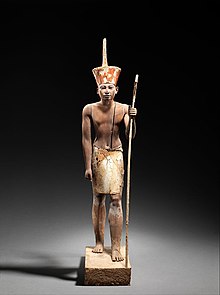

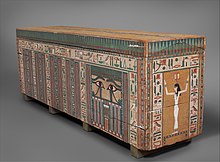
The kings of the Middle Kingdom restored the country's stability and prosperity, thereby stimulating a resurgence of art, literature, and monumental building projects.[37] Mentuhotep II and his Eleventh Dynasty successors ruled from Thebes, but the vizier Amenemhat I, upon assuming the kingship at the beginning of the Twelfth Dynasty around 1985 BC, shifted the kingdom's capital to the city of Itjtawy, located in Faiyum.[38] From Itjtawy, the kings of the Twelfth Dynasty undertook a far-sighted land reclamation and irrigation scheme to increase agricultural output in the region. Moreover, the military reconquered territory in Nubia that was rich in quarries and gold mines, while laborers built a defensive structure in the Eastern Delta, called the "Walls of the Ruler", to defend against foreign attack.[39]
With the kings having secured the country militarily and politically and with vast agricultural and mineral wealth at their disposal, the nation's population, arts, and religion flourished. In contrast to elitist Old Kingdom attitudes towards the gods, the Middle Kingdom displayed an increase in expressions of personal piety.[40] Middle Kingdom literature featured sophisticated themes and characters written in a confident, eloquent style.[33] The relief and portrait sculpture of the period captured subtle, individual details that reached new heights of technical sophistication.[41]
The last great ruler of the Middle Kingdom, Amenemhat III, allowed Semitic-speaking Canaanite settlers from the Near East into the Delta region to provide a sufficient labor force for his especially active mining and building campaigns. These ambitious building and mining activities, however, combined with severe Nile floods later in his reign, strained the economy and precipitated the slow decline into the Second Intermediate Period during the later Thirteenth and Fourteenth dynasties. During this decline, the Canaanite settlers began to assume greater control of the Delta region, eventually coming to power in Egypt as the Hyksos.[42]
Second Intermediate Period (1674–1549 BC) and the Hyksos
Around 1785 BC, as the power of the Middle Kingdom kings weakened, a Western Asian people called the Hyksos, who had already settled in the Delta, seized control of Egypt and established their capital at Avaris, forcing the former central government to retreat to Thebes. The king was treated as a vassal and expected to pay tribute.[43] The Hyksos ("foreign rulers") retained Egyptian models of government and identified as kings, thereby integrating Egyptian elements into their culture. They and other invaders introduced new tools of warfare into Egypt, most notably the composite bow and the horse-drawn chariot.[44]
After retreating south, the native Theban kings found themselves trapped between the Canaanite Hyksos ruling the north and the Hyksos' Nubian allies, the Kushites, to the south. After years of vassalage, Thebes gathered enough strength to challenge the Hyksos in a conflict that lasted more than 30 years, until 1555 BC.[43] The kings Seqenenre Tao II and Kamose were ultimately able to defeat the Nubians to the south of Egypt, but failed to defeat the Hyksos. That task fell to Kamose's successor, Ahmose I, who successfully waged a series of campaigns that permanently eradicated the Hyksos' presence in Egypt. He established a new dynasty and, in the New Kingdom that followed, the military became a central priority for the kings, who sought to expand Egypt's borders and attempted to gain mastery of the Near East.[45]
New Kingdom (1549–1069 BC)

The New Kingdom pharaohs established a period of unprecedented prosperity by securing their borders and strengthening diplomatic ties with their neighbours, including the Mitanni Empire, Assyria, and Canaan. Military campaigns waged under Tuthmosis I and his grandson Tuthmosis III extended the influence of the pharaohs to the largest empire Egypt had ever seen. Beginning with Merneptah the rulers of Egypt adopted the title of pharaoh.
Between their reigns, Hatshepsut, a queen who established herself as pharaoh, launched many building projects, including the restoration of temples damaged by the Hyksos, and sent trading expeditions to Punt and the Sinai.[46] When Tuthmosis III died in 1425 BC, Egypt had an empire extending from Niya in north west Syria to the Fourth Cataract of the Nile in Nubia, cementing loyalties and opening access to critical imports such as bronze and wood.[47]
The New Kingdom pharaohs began a large-scale building campaign to promote the god Amun, whose growing cult was based in Karnak. They also constructed monuments to glorify their own achievements, both real and imagined. The Karnak temple is the largest Egyptian temple ever built.[48]
Around 1350 BC, the stability of the New Kingdom was threatened when Amenhotep IV ascended the throne and instituted a series of radical and chaotic reforms. Changing his name to Akhenaten, he touted the previously obscure sun deity Aten as the supreme deity, suppressed the worship of most other deities, and moved the capital to the new city of Akhetaten (modern-day Amarna).[49] He was devoted to his new religion and artistic style. After his death, the cult of the Aten was quickly abandoned and the traditional religious order restored. The subsequent pharaohs, Tutankhamun, Ay, and Horemheb, worked to erase all mention of Akhenaten's heresy, now known as the Amarna Period.[50]

Around 1279 BC, Ramesses II, also known as Ramesses the Great, ascended the throne, and went on to build more temples, erect more statues and obelisks, and sire more children than any other pharaoh in history.[a] A bold military leader, Ramesses II led his army against the Hittites in the Battle of Kadesh (in modern Syria) and, after fighting to a stalemate, finally agreed to the first recorded peace treaty, around 1258 BC.[51]
Egypt's wealth, however, made it a tempting target for invasion, particularly by the Libyan Berbers to the west, and the Sea Peoples, a conjectured confederation of seafarers from the Aegean Sea.[b] Initially, the military was able to repel these invasions, but Egypt eventually lost control of its remaining territories in southern Canaan, much of it falling to the Assyrians. The effects of external threats were exacerbated by internal problems such as corruption, tomb robbery, and civil unrest. After regaining their power, the high priests at the temple of Amun in Thebes accumulated vast tracts of land and wealth, and their expanded power splintered the country during the Third Intermediate Period.[52]
Third Intermediate Period (1069–653 BC)
Following the death of Ramesses XI in 1078 BC, Smendes assumed authority over the northern part of Egypt, ruling from the city of Tanis. The south was effectively controlled by the High Priests of Amun at Thebes, who recognized Smendes in name only.[53] During this time, Libyans had been settling in the western delta, and chieftains of these settlers began increasing their autonomy. Libyan princes took control of the delta under Shoshenq I in 945 BC, founding the so-called Libyan or Bubastite dynasty that would rule for some 200 years. Shoshenq also gained control of southern Egypt by placing his family members in important priestly positions. Libyan control began to erode as a rival dynasty in the delta arose in Leontopolis, and Kushites threatened from the south.

Around 727 BC the Kushite king Piye invaded northward, seizing control of Thebes and eventually the Delta, which established the 25th Dynasty.[55] During the 25th Dynasty, Pharaoh Taharqa created an empire nearly as large as the New Kingdom's. Twenty-fifth Dynasty pharaohs built, or restored, temples and monuments throughout the Nile valley, including at Memphis, Karnak, Kawa, and Jebel Barkal.[56] During this period, the Nile valley saw the first widespread construction of pyramids (many in modern Sudan) since the Middle Kingdom.[57][58][59]
Egypt's far-reaching prestige declined considerably toward the end of the Third Intermediate Period. Its foreign allies had fallen under the Assyrian sphere of influence, and by 700 BC war between the two states became inevitable. Between 671 and 667 BC the Assyrians began the Assyrian conquest of Egypt. The reigns of both Taharqa and his successor, Tanutamun, were filled with constant conflict with the Assyrians, against whom Egypt enjoyed several victories. Ultimately, the Assyrians pushed the Kushites back into Nubia, occupied Memphis, and sacked the temples of Thebes.[60]
Late Period (653–332 BC)
The Assyrians left control of Egypt to a series of vassals who became known as the Saite kings of the Twenty-Sixth Dynasty. By 653 BC, the Saite king Psamtik I was able to oust the Assyrians with the help of Greek mercenaries, who were recruited to form Egypt's first navy. Greek influence expanded greatly as the city-state of Naucratis became the home of Greeks in the Nile Delta. The Saite kings based in the new capital of Sais witnessed a brief but spirited resurgence in the economy and culture, but in 525 BC, the powerful Persians, led by Cambyses II, began their conquest of Egypt, eventually capturing the pharaoh Psamtik III at the Battle of Pelusium. Cambyses II then assumed the formal title of pharaoh, but ruled Egypt from Iran, leaving Egypt under the control of a satrap. A few successful revolts against the Persians marked the 5th century BC, but Egypt was never able to permanently overthrow the Persians.[61]
Following its annexation by Persia, Egypt was joined with Cyprus and Phoenicia in the sixth satrapy of the Achaemenid Persian Empire. This first period of Persian rule over Egypt, also known as the Twenty-Seventh Dynasty, ended in 402 BC, when Egypt regained independence under a series of native dynasties. The last of these dynasties, the Thirtieth, proved to be the last native royal house of ancient Egypt, ending with the kingship of Nectanebo II. A brief restoration of Persian rule, sometimes known as the Thirty-First Dynasty, began in 343 BC, but shortly after, in 332 BC, the Persian ruler Mazaces handed Egypt over to Alexander the Great without a fight.[62]
Ptolemaic period (332–30 BC)

In 332 BC, Alexander the Great conquered Egypt with little resistance from the Persians and was welcomed by the Egyptians as a deliverer. The administration established by Alexander's successors, the Macedonian Ptolemaic Kingdom, was based on an Egyptian model and based in the new capital city of Alexandria. The city showcased the power and prestige of Hellenistic rule, and became a centre of learning and culture, that included the famous Library of Alexandria as part of the Mouseion.[63] The Lighthouse of Alexandria lit the way for the many ships that kept trade flowing through the city—as the Ptolemies made commerce and revenue-generating enterprises, such as papyrus manufacturing, their top priority.[64]
Hellenistic culture did not supplant native Egyptian culture, as the Ptolemies supported time-honored traditions in an effort to secure the loyalty of the populace. They built new temples in Egyptian style, supported traditional cults, and portrayed themselves as pharaohs. Some traditions merged, as Greek and Egyptian gods were syncretized into composite deities, such as Serapis, and classical Greek forms of sculpture influenced traditional Egyptian motifs. Despite their efforts to appease the Egyptians, the Ptolemies were challenged by native rebellion, bitter family rivalries, and the powerful mob of Alexandria that formed after the death of Ptolemy IV.[65] In addition, as Rome relied more heavily on imports of grain from Egypt, the Romans took great interest in the political situation in the country. Continued Egyptian revolts, ambitious politicians, and powerful opponents from the Near East made this situation unstable, leading Rome to send forces to secure the country as a province of its empire.[66]
Roman period (30 BC – AD 641)
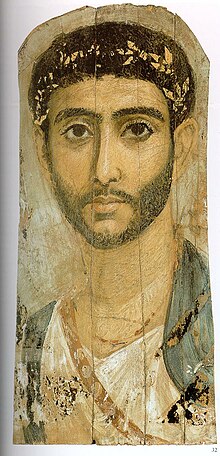
Egypt became a province of the Roman Empire in 30 BC, following the defeat of Mark Antony and Ptolemaic Queen Cleopatra VII by Octavian (later Emperor Augustus) in the Battle of Actium. The Romans relied heavily on grain shipments from Egypt, and the Roman army, under the control of a prefect appointed by the emperor, quelled rebellions, strictly enforced the collection of heavy taxes, and prevented attacks by bandits, which had become a notorious problem during the period.[67] Alexandria became an increasingly important center on the trade route with the orient, as exotic luxuries were in high demand in Rome.[68]
Although the Romans had a more hostile attitude than the Greeks towards the Egyptians, some traditions such as mummification and worship of the traditional gods continued.[69] The art of mummy portraiture flourished, and some Roman emperors had themselves depicted as pharaohs, though not to the extent that the Ptolemies had. The former lived outside Egypt and did not perform the ceremonial functions of Egyptian kingship. Local administration became Roman in style and closed to native Egyptians.[69]
From the mid-first century AD, Christianity took root in Egypt and it was originally seen as another cult that could be accepted. However, it was an uncompromising religion that sought to win converts from the pagan Egyptian and Greco-Roman religions and threatened popular religious traditions. This led to the persecution of converts to Christianity, culminating in the great purges of Diocletian starting in 303, but eventually Christianity won out.[70] In 391, the Christian emperor Theodosius introduced legislation that banned pagan rites and closed temples.[71] Alexandria became the scene of great anti-pagan riots with public and private religious imagery destroyed.[72] As a consequence, Egypt's native religious culture was continually in decline. While the native population continued to speak their language, the ability to read hieroglyphic writing slowly disappeared as the role of the Egyptian temple priests and priestesses diminished. The temples themselves were sometimes converted to churches or abandoned to the desert.[73]
In the fourth century, as the Roman Empire divided, Egypt found itself in the Eastern Empire with its capital at Constantinople. In the waning years of the Empire, Egypt fell to the Sasanian Persian army in the Sasanian conquest of Egypt (618–628). It was then recaptured by the Byzantine emperor Heraclius (629–639), and was finally captured by Muslim Rashidun army in 639–641, marking the end of both Byzantine rule and of the period typically considered Ancient Egypt.[citation needed]
Government and economy
Administration and commerce
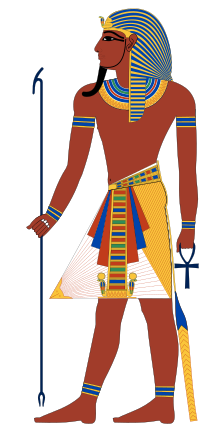
The pharaoh was the absolute monarch of the country and, at least in theory, wielded complete control of the land and its resources. The king was the supreme military commander and head of the government, who relied on a bureaucracy of officials to manage his affairs. In charge of the administration was his second in command, the vizier, who acted as the king's representative and coordinated land surveys, the treasury, building projects, the legal system, and the archives.[74] At a regional level, the country was divided into as many as 42 administrative regions called nomes each governed by a nomarch, who was accountable to the vizier for his jurisdiction. The temples formed the backbone of the economy. Not only were they places of worship, but were also responsible for collecting and storing the kingdom's wealth in a system of granaries and treasuries administered by overseers, who redistributed grain and goods.[75]
Much of the economy was centrally organized and strictly controlled. Although the ancient Egyptians did not use coinage until the Late period,[76] they did use a type of money-barter system,[77] with standard sacks of grain and the deben, a weight of roughly 91 grams (3 oz) of copper or silver, forming a common denominator.[78] Workers were paid in grain; a simple laborer might earn 5+1⁄2 sacks (200 kg or 400 lb) of grain per month, while a foreman might earn 7+1⁄2 sacks (250 kg or 550 lb). Prices were fixed across the country and recorded in lists to facilitate trading; for example a shirt cost five copper deben, while a cow cost 140 deben.[78] Grain could be traded for other goods, according to the fixed price list.[78] During the fifth century BC coined money was introduced into Egypt from abroad. At first the coins were used as standardized pieces of precious metal rather than true money, but in the following centuries international traders came to rely on coinage.[79]
Social status
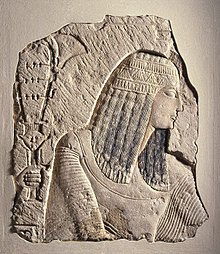
Egyptian society was highly stratified, and social status was expressly displayed. Farmers made up the bulk of the population, but agricultural produce was owned directly by the state, temple, or noble family that owned the land.[80] Farmers were also subject to a labor tax and were required to work on irrigation or construction projects in a corvée system.[81] Artists and craftsmen were of higher status than farmers, but they were also under state control, working in the shops attached to the temples and paid directly from the state treasury. Scribes and officials formed the upper class in ancient Egypt, known as the "white kilt class" in reference to the bleached linen garments that served as a mark of their rank.[82] The upper class prominently displayed their social status in art and literature. Below the nobility were the priests, physicians, and engineers with specialized training in their field. It is unclear whether slavery as understood today existed in ancient Egypt; there is difference of opinions among authors.[83]
The ancient Egyptians viewed men and women, including people from all social classes, as essentially equal under the law, and even the lowliest peasant was entitled to petition the vizier and his court for redress.[84] Although slaves were mostly used as indentured servants, they were able to buy and sell their servitude, work their way to freedom or nobility, and were usually treated by doctors in the workplace.[85] Both men and women had the right to own and sell property, make contracts, marry and divorce, receive inheritance, and pursue legal disputes in court. Married couples could own property jointly and protect themselves from divorce by agreeing to marriage contracts, which stipulated the financial obligations of the husband to his wife and children should the marriage end. Compared with their counterparts in ancient Greece, Rome, and even more modern places around the world, ancient Egyptian women had a greater range of personal choices, legal rights, and opportunities for achievement. Women such as Hatshepsut and Cleopatra VII even became pharaohs, while others wielded power as Divine Wives of Amun. Despite these freedoms, ancient Egyptian women did not often take part in official roles in the administration, aside from the royal high priestesses, apparently served only secondary roles in the temples (not much data for many dynasties), and were not so likely to be as educated as men.[84]
Legal system

The head of the legal system was officially the pharaoh, who was responsible for enacting laws, delivering justice, and maintaining law and order, a concept the ancient Egyptians referred to as Ma'at.[74] Although no legal codes from ancient Egypt survive, court documents show that Egyptian law was based on a common-sense view of right and wrong that emphasized reaching agreements and resolving conflicts rather than strictly adhering to a complicated set of statutes.[84] Local councils of elders, known as Kenbet in the New Kingdom, were responsible for ruling in court cases involving small claims and minor disputes.[74] More serious cases involving murder, major land transactions, and tomb robbery were referred to the Great Kenbet, over which the vizier or pharaoh presided. Plaintiffs and defendants were expected to represent themselves and were required to swear an oath that they had told the truth. In some cases, the state took on both the role of prosecutor and judge, and it could torture the accused with beatings to obtain a confession and the names of any co-conspirators. Whether the charges were trivial or serious, court scribes documented the complaint, testimony, and verdict of the case for future reference.[86]
Punishment for minor crimes involved either imposition of fines, beatings, facial mutilation, or exile, depending on the severity of the offense. Serious crimes such as murder and tomb robbery were punished by execution, carried out by decapitation, drowning, or impaling the criminal on a stake. Punishment could also be extended to the criminal's family.[74] Beginning in the New Kingdom, oracles played a major role in the legal system, dispensing justice in both civil and criminal cases. The procedure was to ask the god a "yes" or "no" question concerning the right or wrong of an issue. The god, carried by a number of priests, rendered judgement by choosing one or the other, moving forward or backward, or pointing to one of the answers written on a piece of papyrus or an ostracon.[87]
Agriculture


A combination of favorable geographical features contributed to the success of ancient Egyptian culture, the most important of which was the rich fertile soil resulting from annual inundations of the Nile River. The ancient Egyptians were thus able to produce an abundance of food, allowing the population to devote more time and resources to cultural, technological, and artistic pursuits. Land management was crucial in ancient Egypt because taxes were assessed based on the amount of land a person owned.[88]
Farming in Egypt was dependent on the cycle of the Nile River. The Egyptians recognized three seasons: Akhet (flooding), Peret (planting), and Shemu (harvesting). The flooding season lasted from June to September, depositing on the river's banks a layer of mineral-rich silt ideal for growing crops. After the floodwaters had receded, the growing season lasted from October to February. Farmers plowed and planted seeds in the fields, which were irrigated with ditches and canals. Egypt received little rainfall, so farmers relied on the Nile to water their crops.[89] From March to May, farmers used sickles to harvest their crops, which were then threshed with a flail to separate the straw from the grain. Winnowing removed the chaff from the grain, and the grain was then ground into flour, brewed to make beer, or stored for later use.[90]
The ancient Egyptians cultivated emmer and barley, and several other cereal grains, all of which were used to make the two main food staples of bread and beer.[91] Flax plants, uprooted before they started flowering, were grown for the fibers of their stems. These fibers were split along their length and spun into thread, which was used to weave sheets of linen and to make clothing. Papyrus growing on the banks of the Nile River was used to make paper. Vegetables and fruits were grown in garden plots, close to habitations and on higher ground, and had to be watered by hand. Vegetables included leeks, garlic, melons, squashes, pulses, lettuce, and other crops, in addition to grapes that were made into wine.[92]

Animals
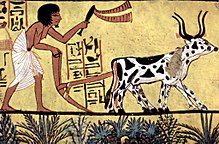
The Egyptians believed that a balanced relationship between people and animals was an essential element of the cosmic order; thus humans, animals and plants were believed to be members of a single whole.[93] Animals, both domesticated and wild, were therefore a critical source of spirituality, companionship, and sustenance to the ancient Egyptians. Cattle were the most important livestock; the administration collected taxes on livestock in regular censuses, and the size of a herd reflected the prestige and importance of the estate or temple that owned them. In addition to cattle, the ancient Egyptians kept sheep, goats, and pigs. Poultry, such as ducks, geese, and pigeons, were captured in nets and bred on farms, where they were force-fed with dough to fatten them.[94] The Nile provided a plentiful source of fish. Bees were also domesticated from at least the Old Kingdom, and provided both honey and wax.[95]
The ancient Egyptians used donkeys and oxen as beasts of burden, and they were responsible for plowing the fields and trampling seed into the soil. The slaughter of a fattened ox was also a central part of an offering ritual. Horses were introduced by the Hyksos in the Second Intermediate Period. Camels, although known from the New Kingdom, were not used as beasts of burden until the Late Period. There is also evidence to suggest that elephants were briefly used in the Late Period but largely abandoned due to lack of grazing land.[94] Cats, dogs, and monkeys were common family pets, while more exotic pets imported from the heart of Africa, such as Sub-Saharan African lions,[96] were reserved for royalty. Herodotus observed that the Egyptians were the only people to keep their animals with them in their houses.[93] During the Late Period, the worship of the gods in their animal form was extremely popular, such as the cat goddess Bastet and the ibis god Thoth, and these animals were kept in large numbers for the purpose of ritual sacrifice.[97]
Natural resources
Egypt is rich in building and decorative stone, copper and lead ores, gold, and semiprecious stones. These natural resources allowed the ancient Egyptians to build monuments, sculpt statues, make tools, and fashion jewelry.[98] Embalmers used salts from the Wadi Natrun for mummification, which also provided the gypsum needed to make plaster.[99] Ore-bearing rock formations were found in distant, inhospitable wadis in the Eastern Desert and the Sinai, requiring large, state-controlled expeditions to obtain natural resources found there. There were extensive gold mines in Nubia, and one of the first maps known is of a gold mine in this region. The Wadi Hammamat was a notable source of granite, greywacke, and gold. Flint was the first mineral collected and used to make tools, and flint handaxes are the earliest pieces of evidence of habitation in the Nile valley. Nodules of the mineral were carefully flaked to make blades and arrowheads of moderate hardness and durability even after copper was adopted for this purpose.[100] Ancient Egyptians were among the first to use minerals such as sulfur as cosmetic substances.[101]
The Egyptians worked deposits of the lead ore galena at Gebel Rosas to make net sinkers, plumb bobs, and small figurines. Copper was the most important metal for toolmaking in ancient Egypt and was smelted in furnaces from malachite ore mined in the Sinai.[102] Workers collected gold by washing the nuggets out of sediment in alluvial deposits, or by the more labor-intensive process of grinding and washing gold-bearing quartzite. Iron deposits found in upper Egypt were used in the Late Period.[103] High-quality building stones were abundant in Egypt; the ancient Egyptians quarried limestone all along the Nile valley, granite from Aswan, and basalt and sandstone from the wadis of the Eastern Desert. Deposits of decorative stones such as porphyry, greywacke, alabaster, and carnelian dotted the Eastern Desert and were collected even before the First Dynasty. In the Ptolemaic and Roman Periods, miners worked deposits of emeralds in Wadi Sikait and amethyst in Wadi el-Hudi.[104]
Trade
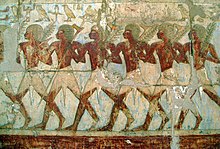
The ancient Egyptians engaged in trade with their foreign neighbors to obtain rare, exotic goods not found in Egypt. In the Predynastic Period, they established trade with Nubia to obtain gold and incense. They also established trade with Palestine, as evidenced by Palestinian-style oil jugs found in the burials of the First Dynasty pharaohs.[105] An Egyptian colony stationed in southern Canaan dates to slightly before the First Dynasty.[106] Narmer had Egyptian pottery produced in Canaan and exported back to Egypt.[107][108]
By the Second Dynasty at latest, ancient Egyptian trade with Byblos yielded a critical source of quality timber not found in Egypt. By the Fifth Dynasty, trade with Punt provided gold, aromatic resins, ebony, ivory, and wild animals such as monkeys and baboons.[109] Egypt relied on trade with Anatolia for essential quantities of tin as well as supplementary supplies of copper, both metals being necessary for the manufacture of bronze. The ancient Egyptians prized the blue stone lapis lazuli, which had to be imported from far-away Afghanistan. Egypt's Mediterranean trade partners also included Greece and Crete, which provided, among other goods, supplies of olive oil.[110]
Language
Historical development
| ||||||
| r n kmt 'Egyptian language' in hieroglyphs | ||||||
|---|---|---|---|---|---|---|
The Egyptian language is a northern Afro-Asiatic language closely related to the Berber and Semitic languages.[111] It has the longest known history of any language having been written from c. 3200 BC to the Middle Ages and remaining as a spoken language for longer. The phases of ancient Egyptian are Old Egyptian, Middle Egyptian (Classical Egyptian), Late Egyptian, Demotic and Coptic.[112] Egyptian writings do not show dialect differences before Coptic, but it was probably spoken in regional dialects around Memphis and later Thebes.[113]
Ancient Egyptian was a synthetic language, but it became more analytic later on. Late Egyptian developed prefixal definite and indefinite articles, which replaced the older inflectional suffixes. There was a change from the older verb–subject–object word order to subject–verb–object.[114] The Egyptian hieroglyphic, hieratic, and demotic scripts were eventually replaced by the more phonetic Coptic alphabet. Coptic is still used in the liturgy of the Egyptian Orthodox Church, and traces of it are found in modern Egyptian Arabic.[115]
Sounds and grammar
Ancient Egyptian has 25 consonants similar to those of other Afro-Asiatic languages. These include pharyngeal and emphatic consonants, voiced and voiceless stops, voiceless fricatives and voiced and voiceless affricates. It has three long and three short vowels, which expanded in Late Egyptian to about nine.[116] The basic word in Egyptian, similar to Semitic and Berber, is a triliteral or biliteral root of consonants and semiconsonants. Suffixes are added to form words. The verb conjugation corresponds to the person. For example, the triconsonantal skeleton S-Ḏ-M is the semantic core of the word 'hear'; its basic conjugation is sḏm, 'he hears'. If the subject is a noun, suffixes are not added to the verb:[117] sḏm ḥmt, 'the woman hears'.
Adjectives are derived from nouns through a process that Egyptologists call nisbation because of its similarity with Arabic.[118] The word order is predicate–subject in verbal and adjectival sentences, and subject–predicate in nominal and adverbial sentences.[119] The subject can be moved to the beginning of sentences if it is long and is followed by a resumptive pronoun.[120] Verbs and nouns are negated by the particle n, but nn is used for adverbial and adjectival sentences. Stress falls on the ultimate or penultimate syllable, which can be open (CV) or closed (CVC).[121]
Writing

Hieroglyphic writing dates from c. 3000 BC, and is composed of hundreds of symbols. A hieroglyph can represent a word, a sound, or a silent determinative; and the same symbol can serve different purposes in different contexts. Hieroglyphs were a formal script, used on stone monuments and in tombs, that could be as detailed as individual works of art. In day-to-day writing, scribes used a cursive form of writing, called hieratic, which was quicker and easier. While formal hieroglyphs may be read in rows or columns in either direction (though typically written from right to left), hieratic was always written from right to left, usually in horizontal rows. A new form of writing, Demotic, became the prevalent writing style, and it is this form of writing—along with formal hieroglyphs—that accompany the Greek text on the Rosetta Stone.[123]
Around the first century AD, the Coptic alphabet started to be used alongside the Demotic script. Coptic is a modified Greek alphabet with the addition of some Demotic signs.[124] Although formal hieroglyphs were used in a ceremonial role until the fourth century, towards the end only a small handful of priests could still read them. As the traditional religious establishments were disbanded, knowledge of hieroglyphic writing was mostly lost. Attempts to decipher them date to the Byzantine[125] and Islamic periods in Egypt,[126] but only in the 1820s, after the discovery of the Rosetta Stone and years of research by Thomas Young and Jean-François Champollion, were hieroglyphs substantially deciphered.[127]
Literature
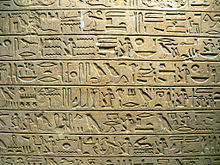
Writing first appeared in association with kingship on labels and tags for items found in royal tombs. It was primarily an occupation of the scribes, who worked out of the Per Ankh institution or the House of Life. The latter comprised offices, libraries (called House of Books), laboratories and observatories.[128] Some of the best-known pieces of ancient Egyptian literature, such as the Pyramid and Coffin Texts, were written in Classical Egyptian, which continued to be the language of writing until about 1300 BC. Late Egyptian was spoken from the New Kingdom onward and is represented in Ramesside administrative documents, love poetry and tales, as well as in Demotic and Coptic texts. During this period, the tradition of writing had evolved into the tomb autobiography, such as those of Harkhuf and Weni. The genre known as Sebayt ("instructions") was developed to communicate teachings and guidance from famous nobles; the Ipuwer papyrus, a poem of lamentations describing natural disasters and social upheaval, is a famous example.
The Story of Sinuhe, written in Middle Egyptian, might be the classic of Egyptian literature.[129] Also written at this time was the Westcar Papyrus, a set of stories told to Khufu by his sons relating the marvels performed by priests.[130] The Instruction of Amenemope is considered a masterpiece of Near Eastern literature.[131] Towards the end of the New Kingdom, the vernacular language was more often employed to write popular pieces like the Story of Wenamun and the Instruction of Any. The former tells the story of a noble who is robbed on his way to buy cedar from Lebanon and of his struggle to return to Egypt. From about 700 BC, narrative stories and instructions, such as the popular Instructions of Onchsheshonqy, as well as personal and business documents were written in the demotic script and phase of Egyptian. Many stories written in demotic during the Greco-Roman period were set in previous historical eras, when Egypt was an independent nation ruled by great pharaohs such as Ramesses II.[132]
Culture
Daily life
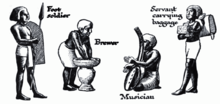
Most ancient Egyptians were farmers tied to the land. Their dwellings were restricted to immediate family members, and were constructed of mudbrick designed to remain cool in the heat of the day. Each home had a kitchen with an open roof, which contained a grindstone for milling grain and a small oven for baking the bread.[133] Ceramics served as household wares for the storage, preparation, transport, and consumption of food, drink, and raw materials. Walls were painted white and could be covered with dyed linen wall hangings. Floors were covered with reed mats, while wooden stools, beds raised from the floor and individual tables comprised the furniture.[134]

The ancient Egyptians placed a great value on hygiene and appearance. Most bathed in the Nile and used a pasty soap made from animal fat and chalk. Men shaved their entire bodies for cleanliness; perfumes and aromatic ointments covered bad odors and soothed skin.[135] Clothing was made from simple linen sheets that were bleached white, and both men and women of the upper classes wore wigs, jewelry, and cosmetics. Children went without clothing until maturity, at about age 12, and at this age males were circumcised and had their heads shaved. Mothers were responsible for taking care of the children, while the father provided the family's income.[136]
Music and dance were popular entertainments for those who could afford them. Early instruments included flutes and harps, while instruments similar to trumpets, oboes, and pipes developed later and became popular. In the New Kingdom, the Egyptians played on bells, cymbals, tambourines, drums, and imported lutes and lyres from Asia.[137] The sistrum was a rattle-like musical instrument that was especially important in religious ceremonies.
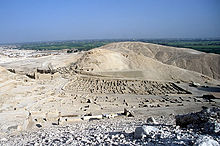
The ancient Egyptians enjoyed a variety of leisure activities, including games and music. Senet, a board game where pieces moved according to random chance, was particularly popular from the earliest times; another similar game was mehen, which had a circular gaming board. "Hounds and Jackals" also known as 58 holes is another example of board games played in ancient Egypt. The first complete set of this game was discovered from a Theban tomb of the Egyptian pharaoh Amenemhat IV that dates to the 13th Dynasty.[138] Juggling and ball games were popular with children, and wrestling is also documented in a tomb at Beni Hasan.[139] The wealthy members of ancient Egyptian society enjoyed hunting, fishing, and boating as well.
The excavation of the workers' village of Deir el-Medina has resulted in one of the most thoroughly documented accounts of community life in the ancient world, which spans almost four hundred years. There is no comparable site in which the organization, social interactions, and working and living conditions of a community have been studied in such detail.[140]
Cuisine
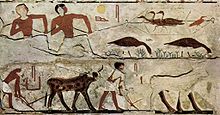
Egyptian cuisine remained remarkably stable over time; indeed, the cuisine of modern Egypt retains some striking similarities to the cuisine of the ancients. The staple diet consisted of bread and beer, supplemented with vegetables such as onions and garlic, and fruit such as dates and figs. Wine and meat were enjoyed by all on feast days while the upper classes indulged on a more regular basis. Fish, meat, and fowl could be salted or dried, and could be cooked in stews or roasted on a grill.[141]
Architecture
The architecture of ancient Egypt includes some of the most famous structures in the world: the Great Pyramids of Giza and the temples at Thebes. Building projects were organized and funded by the state for religious and commemorative purposes, but also to reinforce the wide-ranging power of the pharaoh. The ancient Egyptians were skilled builders; using only simple but effective tools and sighting instruments, architects could build large stone structures with great accuracy and precision that is still envied today.[142]
The domestic dwellings of elite and ordinary Egyptians alike were constructed from perishable materials such as mudbricks and wood, and have not survived. Peasants lived in simple homes, while the palaces of the elite and the pharaoh were more elaborate structures. A few surviving New Kingdom palaces, such as those in Malkata and Amarna, show richly decorated walls and floors with scenes of people, birds, water pools, deities and geometric designs.[143] Important structures such as temples and tombs that were intended to last forever were constructed of stone instead of mudbricks. The architectural elements used in the world's first large-scale stone building, Djoser's mortuary complex, include post and lintel supports in the papyrus and lotus motif.[citation needed]
The earliest preserved ancient Egyptian temples, such as those at Giza, consist of single, enclosed halls with roof slabs supported by columns. In the New Kingdom, architects added the pylon, the open courtyard, and the enclosed hypostyle hall to the front of the temple's sanctuary, a style that was standard until the Greco-Roman period.[144] The earliest and most popular tomb architecture in the Old Kingdom was the mastaba, a flat-roofed rectangular structure of mudbrick or stone built over an underground burial chamber. The step pyramid of Djoser is a series of stone mastabas stacked on top of each other. Pyramids were built during the Old and Middle Kingdoms, but most later rulers abandoned them in favor of less conspicuous rock-cut tombs.[145] The use of the pyramid form continued in private tomb chapels of the New Kingdom and in the royal pyramids of Nubia.[146]
-
Model of a household porch and garden, c. 1981–1975 BC
-
The Temple of Dendur, completed by 10 BC, Metropolitan Museum of Art (New York City)
-
The well preserved Temple of Isis from Philae is an example of Egyptian architecture and architectural sculpture
-
Illustration of various types of capitals, by Karl Richard Lepsius
Text je dostupný za podmienok Creative Commons Attribution/Share-Alike License 3.0 Unported; prípadne za ďalších podmienok. Podrobnejšie informácie nájdete na stránke Podmienky použitia.
Antropológia
Aplikované vedy
Bibliometria
Dejiny vedy
Encyklopédie
Filozofia vedy
Forenzné vedy
Humanitné vedy
Knižničná veda
Kryogenika
Kryptológia
Kulturológia
Literárna veda
Medzidisciplinárne oblasti
Metódy kvantitatívnej analýzy
Metavedy
Metodika
Text je dostupný za podmienok Creative
Commons Attribution/Share-Alike License 3.0 Unported; prípadne za ďalších
podmienok.
Podrobnejšie informácie nájdete na stránke Podmienky
použitia.
www.astronomia.sk | www.biologia.sk | www.botanika.sk | www.dejiny.sk | www.economy.sk | www.elektrotechnika.sk | www.estetika.sk | www.farmakologia.sk | www.filozofia.sk | Fyzika | www.futurologia.sk | www.genetika.sk | www.chemia.sk | www.lingvistika.sk | www.politologia.sk | www.psychologia.sk | www.sexuologia.sk | www.sociologia.sk | www.veda.sk I www.zoologia.sk




